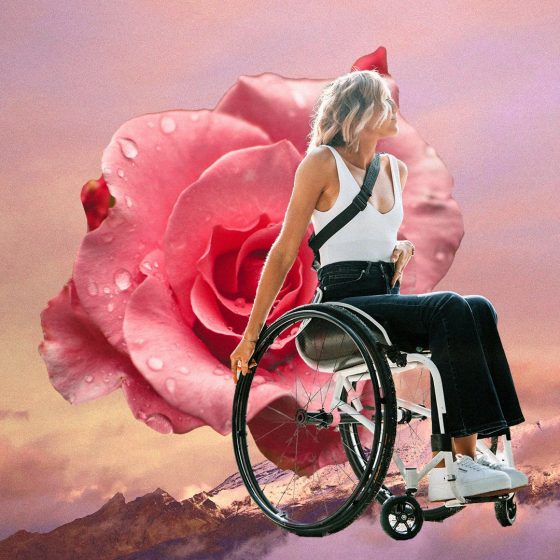I first had sex at the age of 14. As with over 70% of my peers, my first partner was older than me and already prolifically sexually active.
The BMJ Sexual and Reproductive Health Journal identifies this as a major risk factor for poor subsequent sexual health among young people. So it should come as no surprise that the next 13 years was a mixed bag of experiences when it came to sex with heterosexual men, ranging from joyful to intensely traumatic.
An assault at 19 led me to develop a warped perspective of my role between the sheets. I would succumb to degradation to feel in control of my consent, and so trauma accumulated. My performative yet passive manner subsequently meant that the sex I had, no matter how lovely, fun or exciting, was tainted. By the time I was 27 I suffered from extremely low self-esteem. After enduring two abusive relationships back to back, I wanted better for myself, so I came up for air.
One uneventful evening, after a somewhat disappointing glass of white wine, I found myself browsing through a sex toy site. Immediately turned off by the anxiety-inducing anatomical toys and their promises to thrust me into next week, I’d all but given up hope of finding anything. Then, as luck would have it, a simple little number caught my eye and made its way into my basket.
I’m not ashamed to admit that I had my face pressed firmly to the window for the next two-three working days waiting for it to arrive. When it did, it transformed my relationship with my body. Discovering masturbation was earth-shattering because it felt like my body was loving me back, again and again.
Discovering masturbation was earth-shattering because it felt like my body was loving me back, again and again
The neutrality of the design of my sex toy made masturbation accessible to me, but I wanted to know how sex toy companies were championing this. I spoke with Alexandra Fine, CEO of Dame Products, trailblazers of anatomically ambiguous design. I asked: does Dame Products design with sex trauma survivors in mind and if so, how?
“Our products aren’t designed for this purpose, but people who have experienced that trauma are a part of our community, so they have ultimately informed our development and design process. Many recommended products for sex trauma survivors focus on non-fleshy, non-phallic or non-penetrative tools. I think it’s more important to design for pleasure rather than anatomical correctness because only designing for “correct” anatomical parts limits our creativity immensely. Our goal has always been to provide a wide array of tools so people of all sexualities, experiences, and familiarity with sex toys can have pleasurable sex. Exploration is key to feeling safe again, and our variety of vibrators can allow for reconnection with your erotic energy at your own speed. It’s also part of the reason why we create toys in abstract shapes, with neutral colours – to appeal to the most vulva-havers possible.”
This view is shared by Alice DeRock of Wet For Her, an LGBTQ+ focussed sex toy company. They told me that not everyone is looking for products that have an anatomical likeness. For them, it’s about their customer’s bodies and sexualities, making sure that they feel comfortable and secure.
Tabitha Rayne, erotica author and inventor of the vibrator Ruby Glow, explained how sex toys that look less anatomical are easier to connect with and therefore the pathway to orgasmic healing is easier to unlock.
But what exactly is orgasmic healing? I reached out to Gigi Engle, certified sexologist and author of All the F*cking Mistakes: A Guide to Sex, Love, and Life, to understand how we can reclaim power through masturbation. She explained that: “the greatest part of masturbation is that it gives sexual trauma survivors agency over their body, which is something that has been inherently robbed from them. When you bring yourself to orgasm, having chosen the sex toy and you’ve chosen the time and place, you reclaim control. It shows you that your pleasure is available to you.”
Trauma manifests and expresses itself through our psychology and physiology. These manifestations or ‘triggers’ are often alerted by visual stimuli, inciting fear, panic and pain. I asked Gigi if she believes it’s important to have neutrality in femtech? “I think it’s incredibly important. If all of our sex toys look like penises then we need to ask who that’s for. It’s not for women or people with clitorises. Nobody fucking wants that,” she says fervently. “We need to reframe the way we think about sexuality. Neutral sex toys hand the power over to you, outside of the male influence.”
We need to reframe the way we think about sexuality. Neutral sex toys hand the power over to you, outside of the male influence
For me, masturbation was a catalytic moment that bridged a schism I didn’t think possible. Thanks to this surrender I met and comforted the traumatised versions of myself that had been left lingering in limbo. I find myself thankful to sex toy designers because – whether they know it or not – they have given me pieces of myself back I didn’t know were lost. Now, here I am, each piece of me at peace.
That’s not to say that the trauma is gone. But, with masturbation and therapy, I am reconciling. I am moving forward. I know that making that leap wouldn’t have been possible without androgynous design. Quite frankly, its existence was life-saving.









